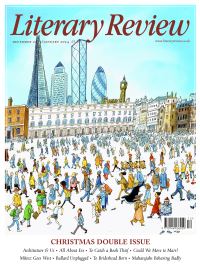Stephanie Barczewski
A Hall of One’s Own
Hidden Patrons: Women and Architectural Patronage in Georgian Britain
By Amy Boyington
Bloomsbury 328pp £19.99
There are, broadly, two methods of studying women in the past. The older, which is known simply as ‘women’s history’, first emerged alongside the feminist movement in the 1960s and developed academically in parallel with social history. It seeks to identify the contribution that women, individually and collectively, made to different historical eras and events. It tends to be biographical in approach, with a focus on particular women whose historical influence has been underappreciated. The second, newer method falls under the heading ‘gender studies’. It views gender as a social construct rather than as an immutable biological characteristic and seeks to illuminate how women have operated alongside men in a world shaped by ever-changing perceptions of gender difference.
Amy Boyington’s Hidden Patrons is very much a work of women’s history. Boyington seeks to uncover how ‘women, when possessed of the necessary funds and autonomy, were able to successfully navigate the limiting social and legal landscape of the eighteenth century to shape their architectural surroundings’. She separates 18th-century women into three categories, unmarried, married and widowed, and makes clear that their ability to wield architectural influence was in large measure determined by which one they belonged to, with widows enjoying by far the greatest autonomy and unmarried women having the least. She then turns to different types of buildings, progressing in turn through country houses, London town houses, villas, estate buildings and landscape gardens to make her case that the contribution of women to Georgian architecture has been significantly underestimated.
Boyington’s approach has clear strengths. There can be no doubt that in thoroughly mining the archives she has unearthed a wealth of previously obscure or overlooked examples. She draws on not only the major London collections but also over a dozen English county and country house archives and several

Sign Up to our newsletter
Receive free articles, highlights from the archive, news, details of prizes, and much more.@Lit_Review
Follow Literary Review on Twitter
Twitter Feed
Under its longest-serving editor, Graydon Carter, Vanity Fair was that rare thing – a New York society magazine that published serious journalism.
@PeterPeteryork looks at what Carter got right.
Peter York - Deluxe Editions
Peter York: Deluxe Editions - When the Going Was Good: An Editor’s Adventures During the Last Golden Age of Magazines by Graydon Carter
literaryreview.co.uk
Henry James returned to America in 1904 with three objectives: to see his brother William, to deliver a series of lectures on Balzac, and to gather material for a pair of books about modern America.
Peter Rose follows James out west.
Peter Rose - The Restless Analyst
Peter Rose: The Restless Analyst - Henry James Comes Home: Rediscovering America in the Gilded Age by Peter Brooks...
literaryreview.co.uk
Vladimir Putin served his apprenticeship in the KGB toward the end of the Cold War, a period during which Western societies were infiltrated by so-called 'illegals'.
Piers Brendon examines how the culture of Soviet spycraft shaped his thinking.
Piers Brendon - Tinker, Tailor, Sleeper, Troll
Piers Brendon: Tinker, Tailor, Sleeper, Troll - The Illegals: Russia’s Most Audacious Spies and the Plot to Infiltrate the West by Shaun Walker
literaryreview.co.uk